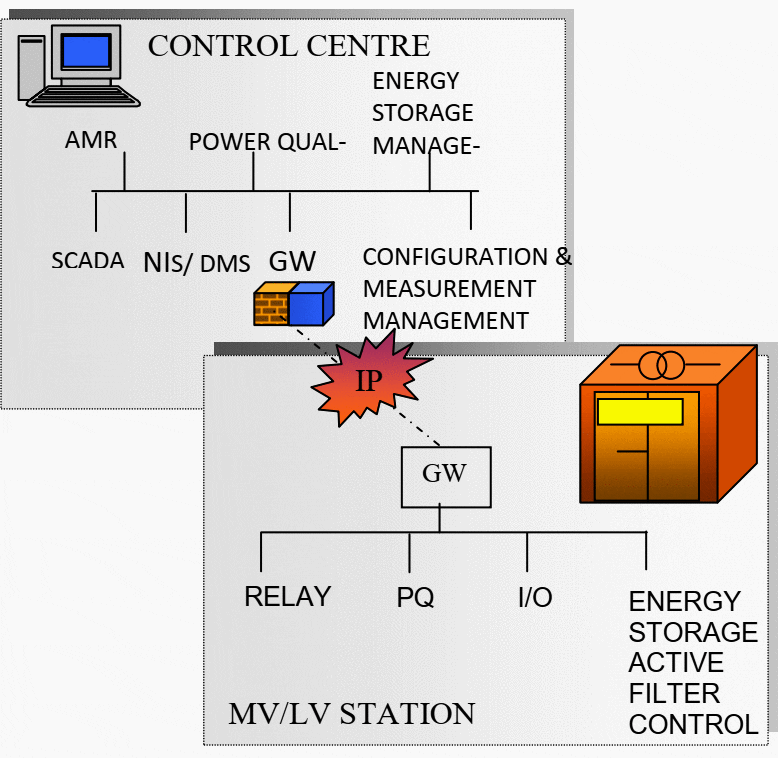Advanced power quality management
Unlike passive filters, active filters do not produce connection overvoltages, because the charge will not be trapped in capacitors similarly. The typical structure of active filters contains an inductor, i.e. filter coil and power electronic converter, i.e. switches and capacitor energy storage.

The active filter converter is typically controlled in such a way that opposite phase harmonic waveforms are produced and harmonic propagation is re-duced or eliminated. In addition to harmonic filtering, the power factor can be corrected by using active filters. In future active filter functions, harmonic filtering and power fac-tor correction could be implemented in the grid side control of the energy storage.
Managements systems and the communication architecture of a MV/LV transformer stations with energy storage are shown on the Figure 1.
The communication architecture of this vision is based on the public intemet and it consists of Ethernet and IP protocols, transformer centre gateways (GW) and the local IP network in the MV/LV transformer station and the control centre. The IP network enables multiple protocols to be used, which can be used e.g. by energy trade, storage management configuration, re-mote control, power quality and web-based services.

An encrypted virtual private network (VPN) could be used, when the traffic is tunnelled through the public network.
Standard IEC protocols are used to control distributed resources and filters. The intelligent logical device of the energy storage could be modelled using the object-oriented structure and architecture defined in IEC 61850 and in its later IEC additions.
The SCADA schematic diagram in Figure 2 shows an MV/LV transformer station with an active filter. It consists of the symbols of the disconnectors of the ring unit, the dis-connectors of the transformer, the transformer, the relay of the LV busbar, the fuse-switches of the LV feeders, and the relay of the feeder of the active filter.
In addition, the active filter (red) and possible measurements and indications are presented.

Extensive monitoring of LV processes and of PQ indices with SCADA contain a high number of points for both measured and calculated values.
The pricing of SCADA products depends on the number of the points needed. This has provided until now a reason-able way for small and large distribution companies to afford SCADA updates. In order to allow large-scale, multi-value LV monitoring, new SCADA and NIS/DMS pricing ways would be needed.
A new pricing that is not based on the number of points could eliminate the unnecessary virtual grouping, structures and condensing of LV information. A relational database, for instance, is capable of handbag very large databases and the processing and memory capacity of the information system has increased exponentially.
Also, high-speed networks have become available and are developing fast. The actual bottleneck could therefore be the pricing of the SCADA product.
| Title: | Intelligent distribution automation of MV/LV transformer stations at LV networks – Johan Nyberg at University of Vaasa, Department of electrical engineering and energy technology |
| Format: | |
| Size: | 2.0 MB |
| Pages: | 187 |
| Download: | Here 🔗 (Get Premium Membership) | Video Courses | Download Updates |



Good morning
Well done
Implementing automation in the electrical and energy industry will allow them to be able to deliver adaptable choices to present consumers who would never let go of modern comfort while also preserving quality. Automation is versatile enough to match the vertical-specific requirements which are likely to vary across the industry. RPA can be executed to provide the best fit for the particular infrastructure of each utility. This article shares great information, thanks for the good read.
Dear sir
Electrical motor single phase & three phase maintenance work.